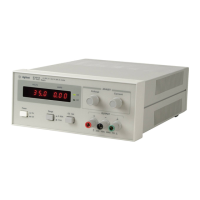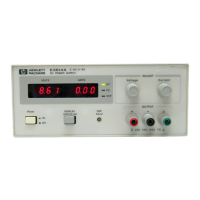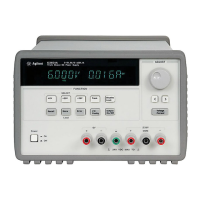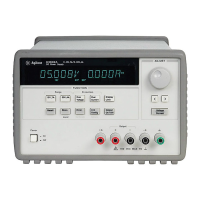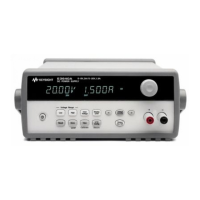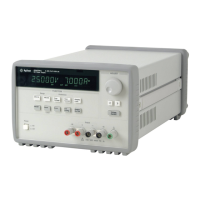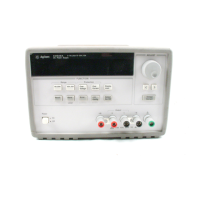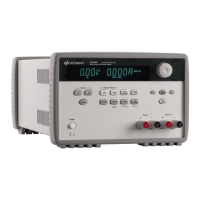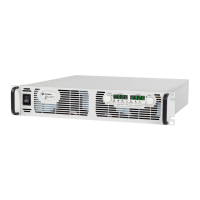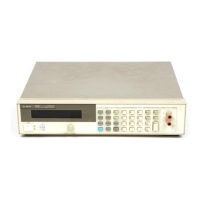A-2
series pass transistors. Whenever the output volta
e is below
the slopin
V1 line, the control circuit inhibits four SCRs and
the input capacitors char
e to a volta
e determined b
N1.
Fi
ure A-2 indicates the windin
s that are connected as a
result of the other volta
e decisions.
Fi
ure A-2. Output Power Plot
The series re
ulators (Q1 and Q4) are part of a feedback loop
which consists of the driver and the Constant Volta
e/Con-
stant Current error amplifier. The series re
ulator feedback
loop provides "fine and fast" re
ulation of the output while the
prere
ulator feedback loop handles lar
e, relativel
slow, re
-
ulation demands.
The re
ulator is made to alter its conduction to maintain a
constant output volta
e or current. The volta
e developed
across the current samplin
resistors (R58 and R59) is the
input to the constant current error amplifier. The constant volt-
a
e error amplifier obtains its input b
samplin
the output
volta
e of the suppl
.
An
chan
es in output volta
e or current are detected and
amplified b
the constant volta
e or constant current error cir-
cuit and applied to the series re
ulator in the correct phase
and amplitude to counteract the chan
e in output volta
e or
current.
Two error amplifiers are included in a CV/CC suppl
, one for
controllin
output volta
e, the other for controllin
output cur-
rent. Since the constant volta
e amplifier tends to achieve
zero output impedance and alters the output current when-
ever the load resistance chan
es, while the constant current
amplifier causes the output impedance to be infinite and
chan
es the output volta
e in response to an
load resis-
tance chan
e, it is obvious that the two amplifiers can not
operate simultaneousl
. For an
iven value of load resis-
tance, the power suppl
must act either as a constant volta
e
source or as a constant current source - it can not be both;
transfer between these two modes is accomplished at a value
of load resistance equal to the ratio of the output volta
e con-
trol settin
to the output current control settin
.
Full protection a
ainst an
overload condition is inherent in
the Constant Volta
e/Constant Current desi
n principle since
there is not an
load condition that can cause an output which
lies outside the operatin
re
ion. For either constant volta
e
or constant current operation, the proper choice of front panel
volta
e and current control settin
s insures optimum pro-
tection for the load device as well as full protection for the
power suppl
.
The reference and bias circuit provides stable reference volt-
a
es which are used b
the constant volta
e/current error
amplifier circuits for comparison purpose. The displa
circuit
provides an indication of output volta
e and current for con-
stant volta
e or constant current operatin
modes.
An operator error or a component failure within the re
ulatin
feedback loop can drive a power suppl
's output volta
e to
man
times its preset value. The overvolta
e protection cir-
cuit is to protect the load a
ainst this possibilit
. The circuit
insures that the power suppl
volta
e across the load will
never exceed a preset limit.
Diode CR19 is connected across the output terminals in
reverse polarit
. It protects the output electrol
tic capacitor
and the series re
ulator transistors from the effects of a
reverse volta
e applied across the output terminals.
The displa
power circuit provides volta
e which is used b
A/
D converter and LED drive.
MAINTENANCE
INTRODUCTION
This section provides performance test and calibration proce-
dures and troubleshootin
information. The followin
opera-
tion verification tests comprise a short procedure to verif
that
the power suppl
is performin
properl
, without testin
all
specified parameters.
If a fault is detected in the power suppl
while makin
the
performance check or durin
normal operation, proceed to
the troubleshootin
procedures. After troubleshootin
, per-
form an
necessar
adjustments and calibrations. Before
returnin
the power suppl
to normal operation, repeat the
performance check to ensure that the fault has been properl
corrected and that no other faults exist.
Test Equipment Required
The followin
Table A-1 lists the equipment required to perform
the tests and adjustments of this section. You can separatel
identif
the equipment for performance tests, calibration, and
troubleshootin
in the USE column of the table.
Operation Verification Tests
The followin
tests assure that the power suppl
is per-
formin
properl
. The
do not, however, check all the speci-
fied parameters tested in the complete performance test
described below. Proceed as follows:
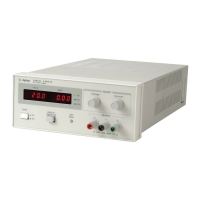
